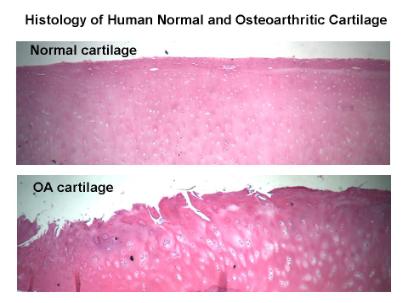The most common type of articular cartilage affliction is osteoarthritis. Osteoarthritis, also known as degenerative joint disease, affects over a third of adults aged 65 and older in the United States, and will undoubtedly become even more common as the U.S. population ages. Arthritis costs the United States $65 billion annually in medical expenses and lost wages. This disease affects articular cartilage, which is incapable of naturally regenerating due to low vascularity and a low cell density. The process of cartilage degradation can arise from cartilage trauma or joint injuries. Once damaged, articular cartilage will degenerate continuously with no healing response. As the cartilage is lost, bone surfaces become unprotected, leading to bone and ligament damage, pain and stiffness in the joint, and loss of mobility for the patient.  This figure shows how osteoarthritis degenerates cartilage over time. |
 With osteoarthritis, the cartilage layer on top of the bone erodes and in the process creates an exceedingly painful situation. At the present, there are no permanent solutions to osteoarthritis. Many therapies exist to treat the symptoms including exercise, weight loss, and pain medication, but none can cure the disease. Certain approaches show promise. As described earlier, the self assembly process is a scaffold-less method that grows cartilage constructs with properties akin to native tissue. The main problem is that there is no way to integrate engineered tissue with native tissue, making this technique not viable as of yet. Various drug therapies have been used in an attempt to reverse cartilage degeneration, but none of them have been proven to work effectively. |
||
Because articular cartilage cannot heal, osteoarthritic changes in joints result in complete destruction, as illustrated in the hip joint at the top (arrows point to exposed bone). These changes necessitating the replacement of the biological but ailing surfaces with metallic and plastic artificial joint surfaces, as shown. |
|||